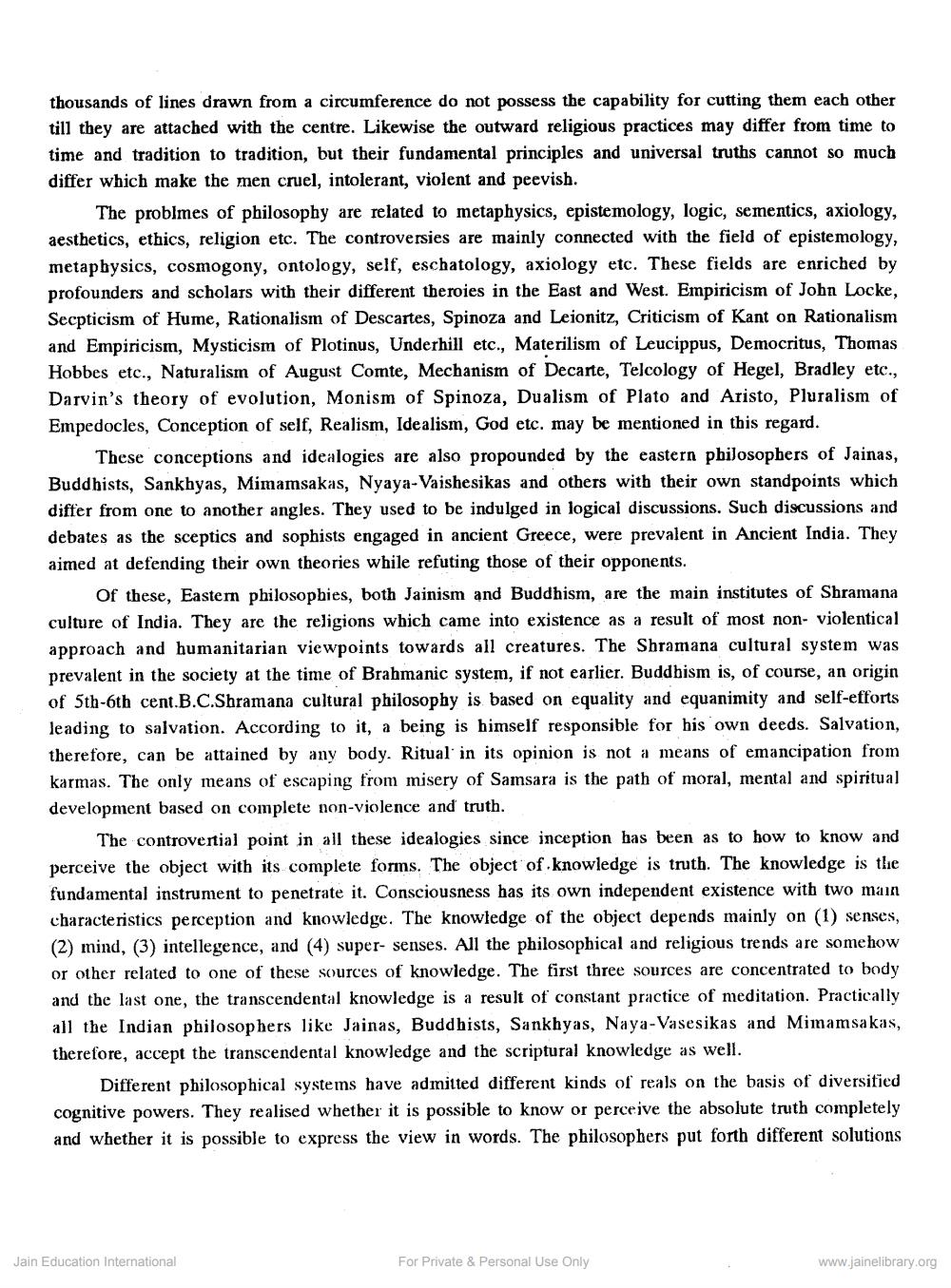________________
thousands of lines drawn from a circumference do not possess the capability for cutting them each other till they are attached with the centre. Likewise the outward religious practices may differ from time to time and tradition to tradition, but their fundamental principles and universal truths cannot so much differ which make the men cruel, intolerant, violent and peevish.
The problmes of philosophy are related to metaphysics, epistemology, logic, sementics, axiology, aesthetics, ethics, religion etc. The controversies are mainly connected with the field of epistemology, metaphysics, cosmogony, ontology, self, eschatology, axiology etc. These fields are enriched by profounders and scholars with their different theroies in the East and West. Empiricism of John Locke, Secpticism of Hume, Rationalism of Descartes, Spinoza and Leionitz, Criticism of Kant on Rationalism and Empiricism, Mysticism of Plotinus, Underhill etc., Materilism of Leucippus, Democritus, Thomas Hobbes etc., Naturalism of August Comte, Mechanism of Decarte, Telcology of Hegel, Bradley etc., Darvin's theory of evolution, Monism of Spinoza, Dualism of Plato and Aristo, Pluralism of Empedocles, Conception of self, Realism, Idealism, God etc. may be mentioned in this regard.
These conceptions and idealogies are also propounded by the eastern philosophers of Jainas, Buddhists, Sankhyas, Mimamsakas, Nyaya-Vaishesikas and others with their own standpoints which differ from one to another angles. They used to be indulged in logical discussions. Such discussions and debates as the sceptics and sophists engaged in ancient Greece, were prevalent in Ancient India. They aimed at defending their own theories while refuting those of their opponents.
of these, Eastern philosophies, both Jainism and Buddhism, are the main institutes of Shramana culture of India. They are the religions which came into existence as a result of most non- violentical approach and humanitarian viewpoints towards all creatures. The Shramana cultural system was prevalent in the society at the time of Brahmanic system, if not earlier. Buddhism is, of course, an origin of 5th-6th cent.B.C.Shramana cultural philosophy is based on equality and equanimity and self-efforts leading to salvation. According to it, a being is himself responsible for his own deeds. Salvation, therefore, can be attained by any body. Ritual in its opinion is not a means of emancipation from karmas. The only means of escaping from misery of Samsara is the path of moral, mental and spiritual development based on complete non-violence and truth.
The controvertial point in all these idealogies since inception has been as to how to know and perceive the object with its complete forms. The object of knowledge is truth. The knowledge is the fundamental instrument to penetrate it. Consciousness has its own independent existence with two main characteristics perception and knowledge. The knowledge of the object depends mainly on (1) senses, (2) mind, (3) intellegence, and (4) super- senses. All the philosophical and religious trends are somehow or other related to one of these sources of knowledge. The first three sources are concentrated to body and the last one, the transcendental knowledge is a result of constant practice of meditation. Practically all the Indian philosophers like Jainas, Buddhists, Sankhyas, Naya-Vasesikas and Mimamsakas, therefore, accept the transcendental knowledge and the scriptural knowledge as well.
Different philosophical systems have admitted different kinds of reals on the basis of diversified cognitive powers. They realised whether it is possible to know or perceive the absolute truth completely and whether it is possible to express the view in words. The philosophers put forth different solutions
Jain Education International
For Private & Personal Use Only
www.jainelibrary.org




